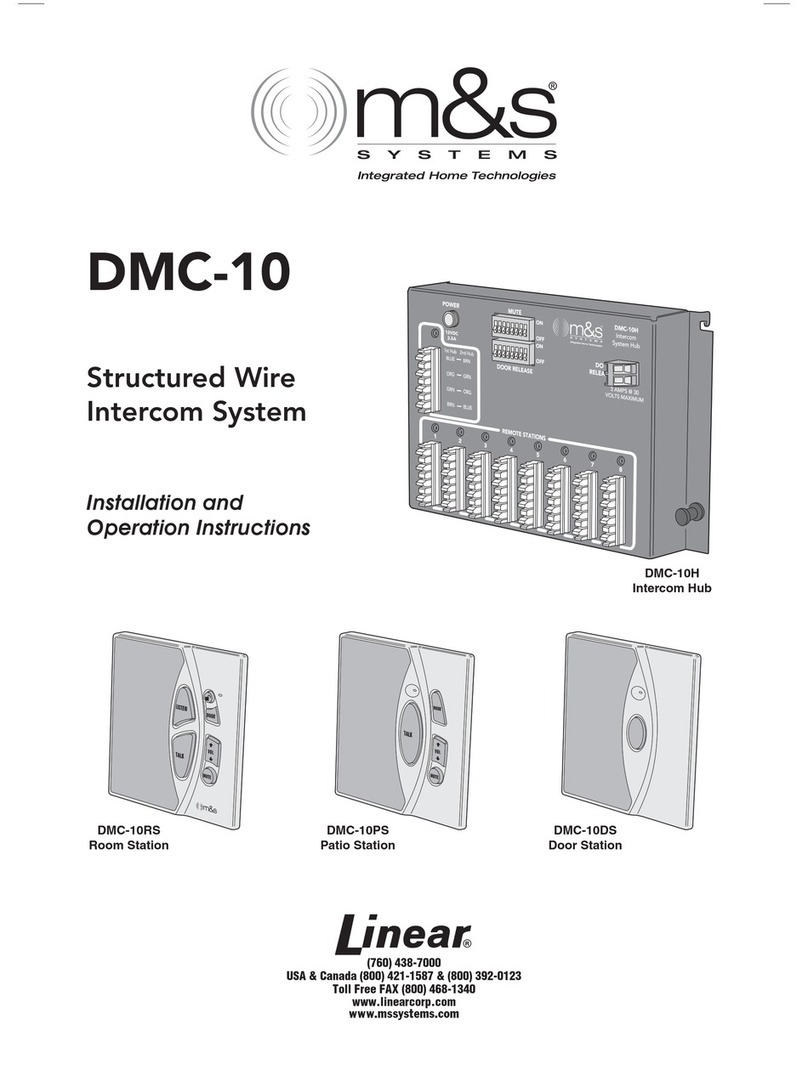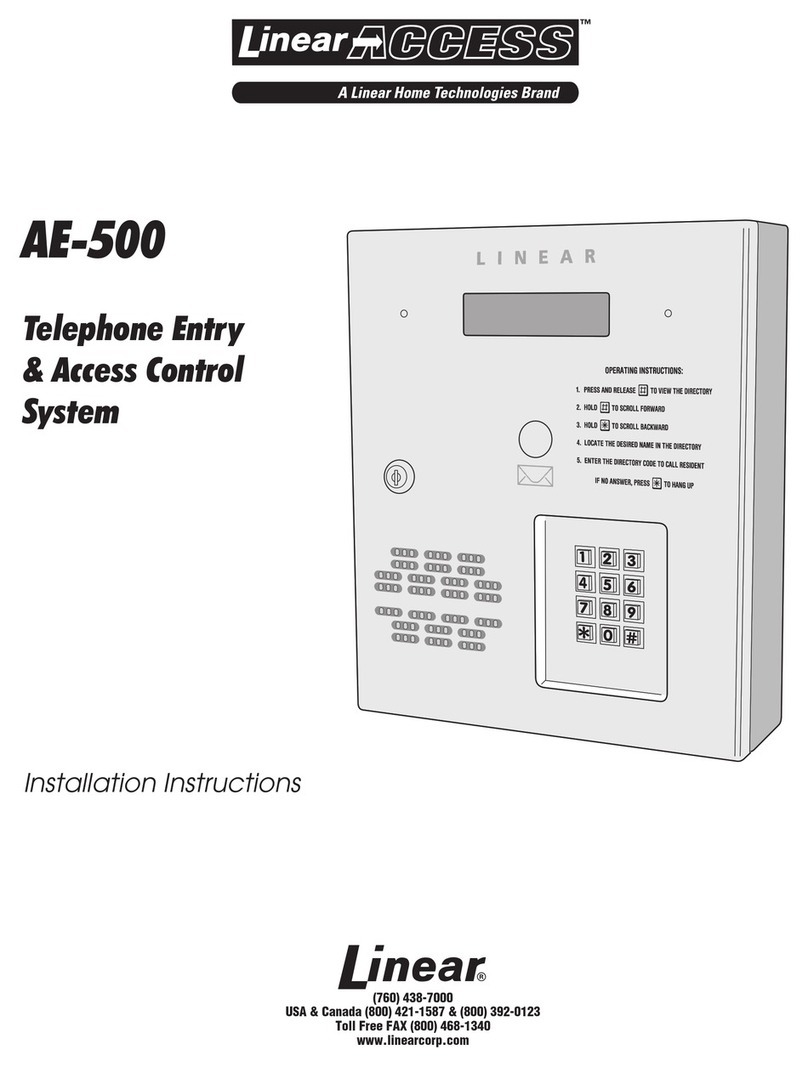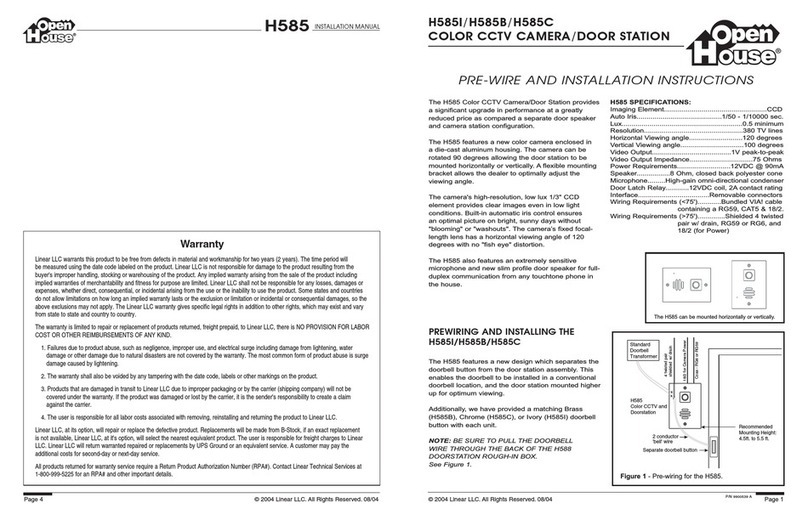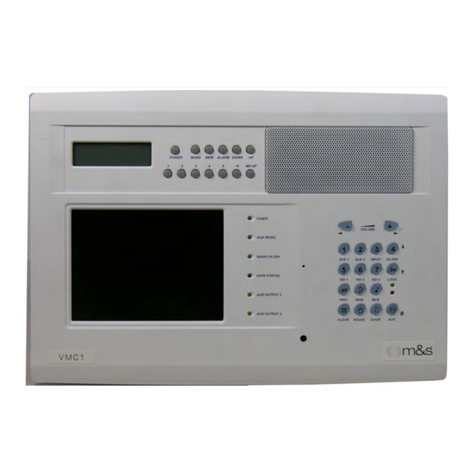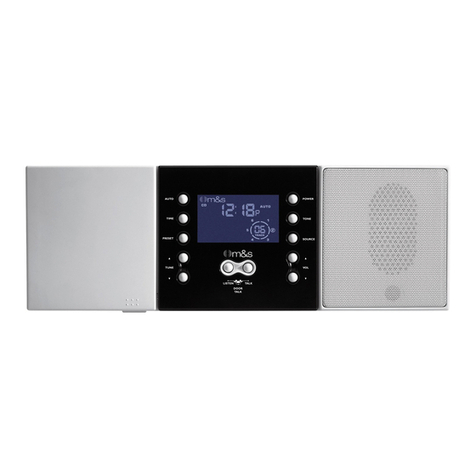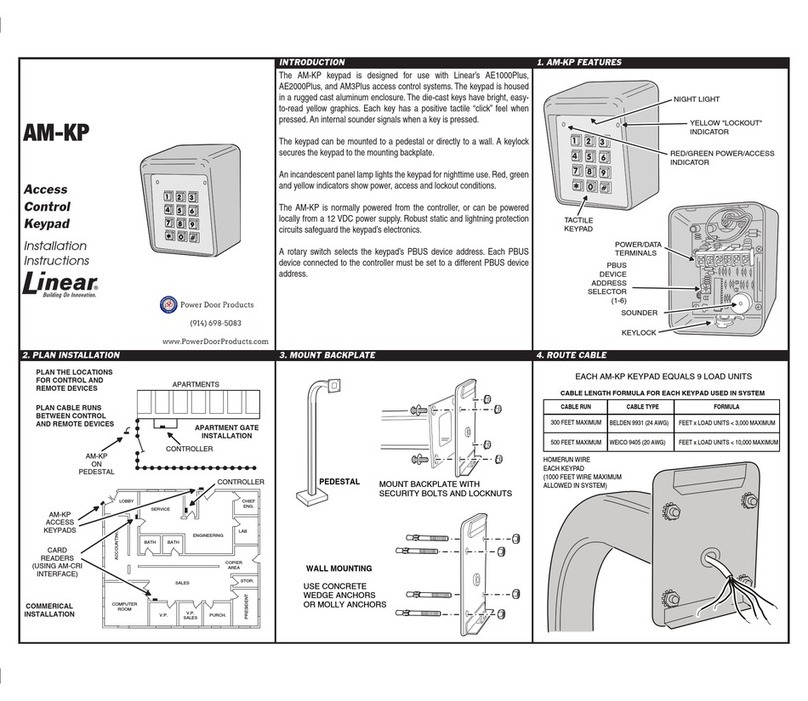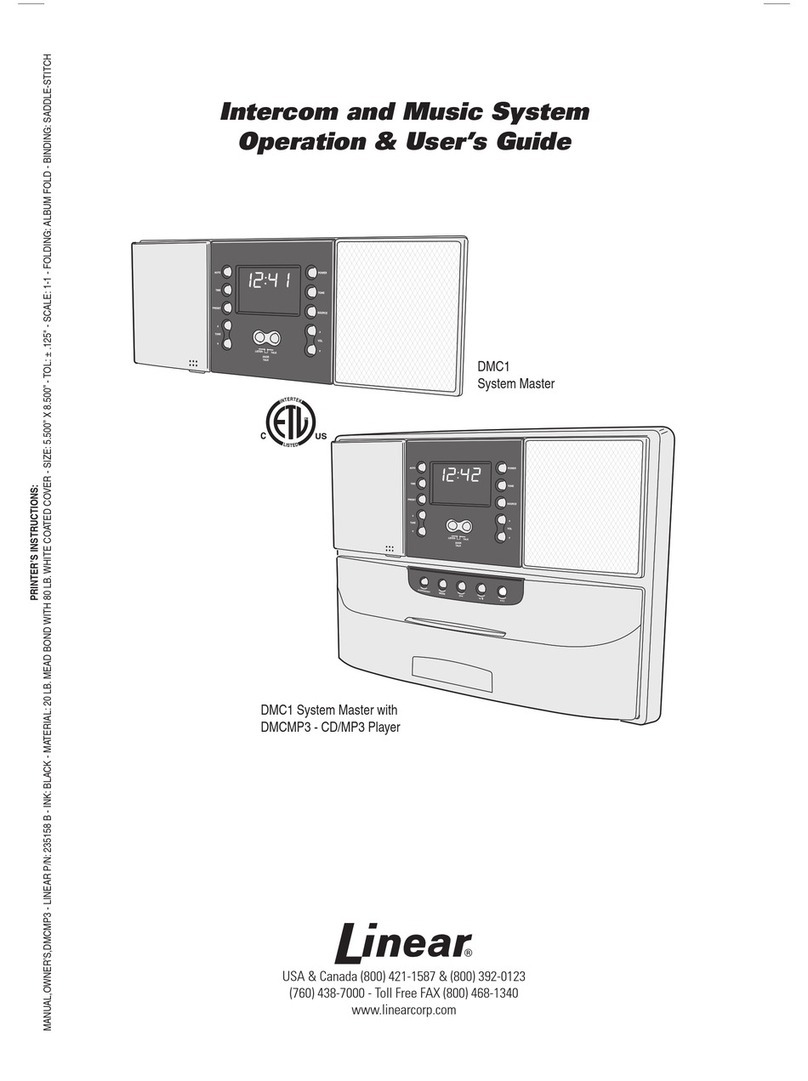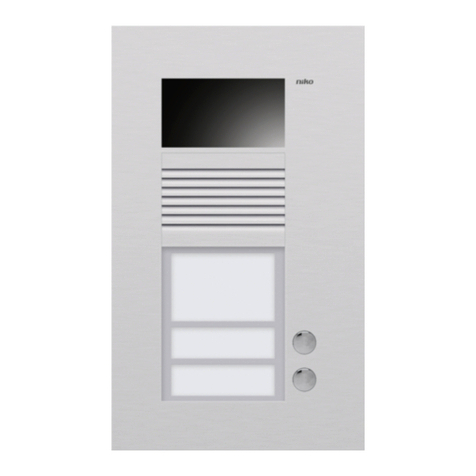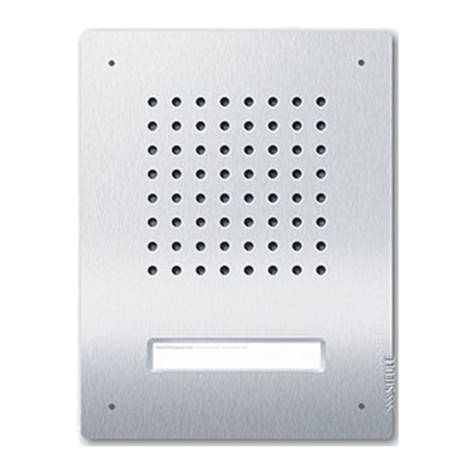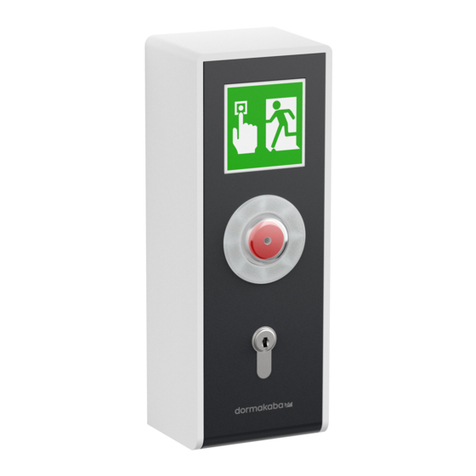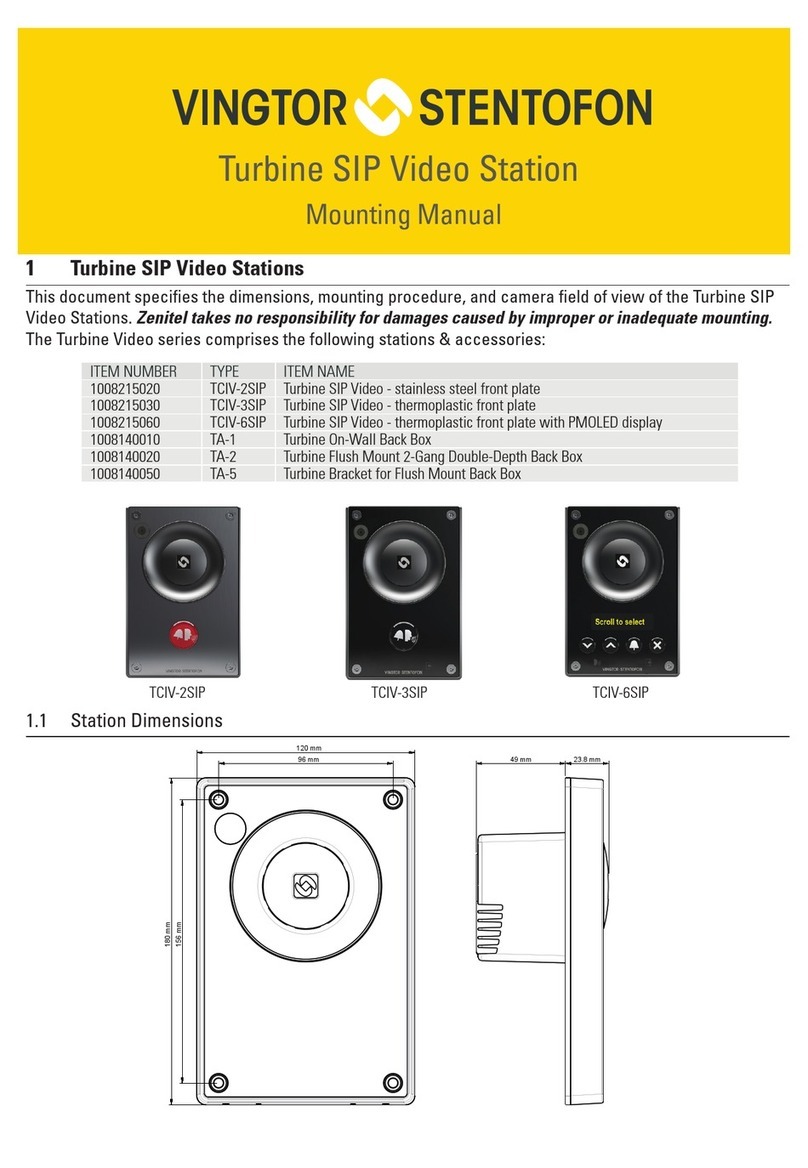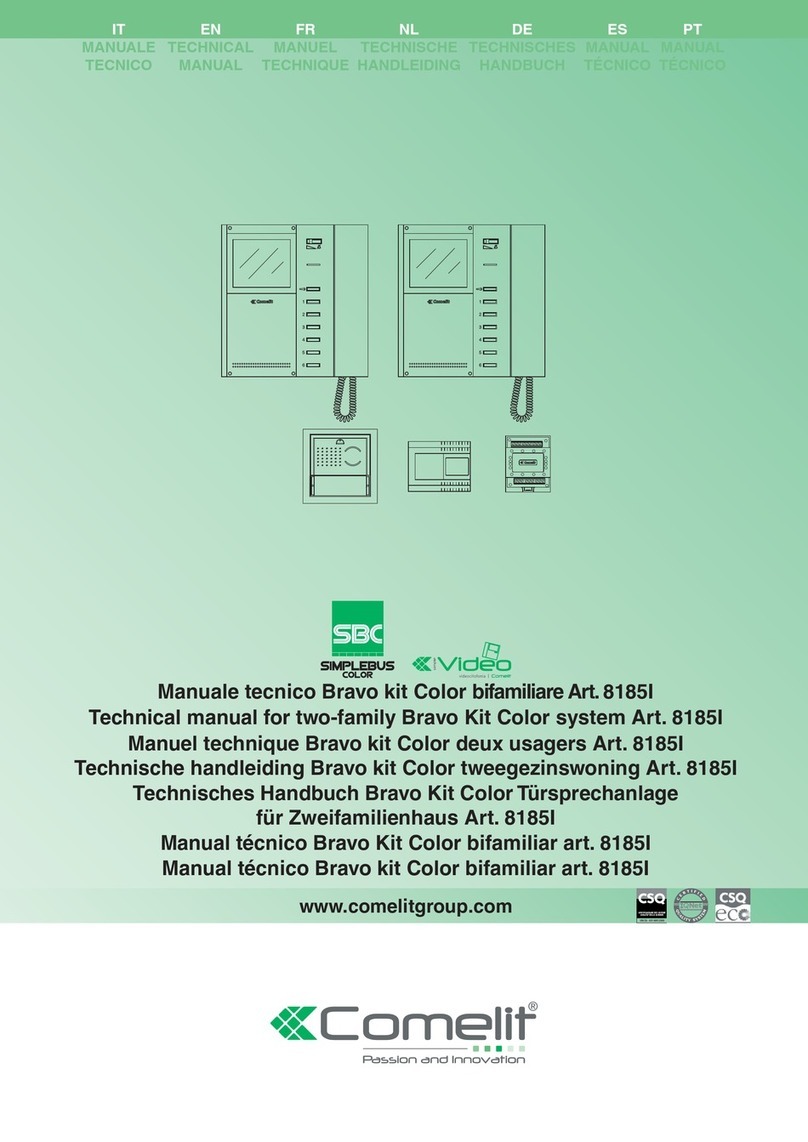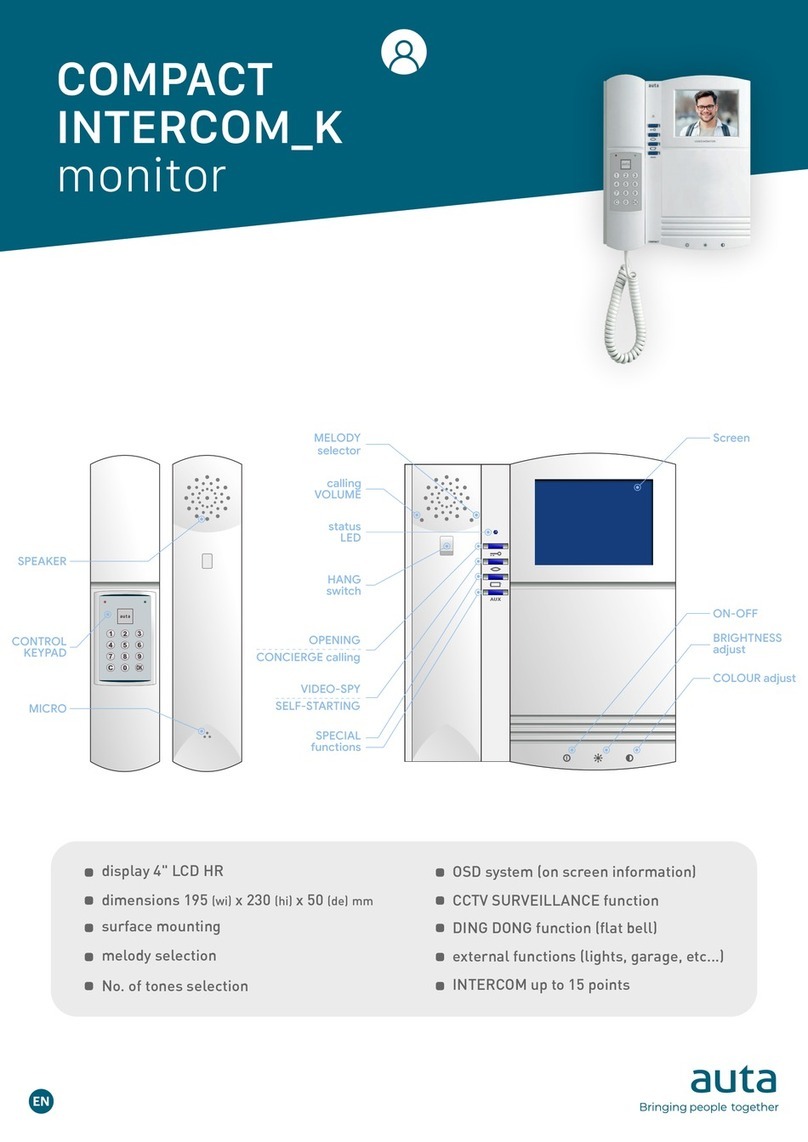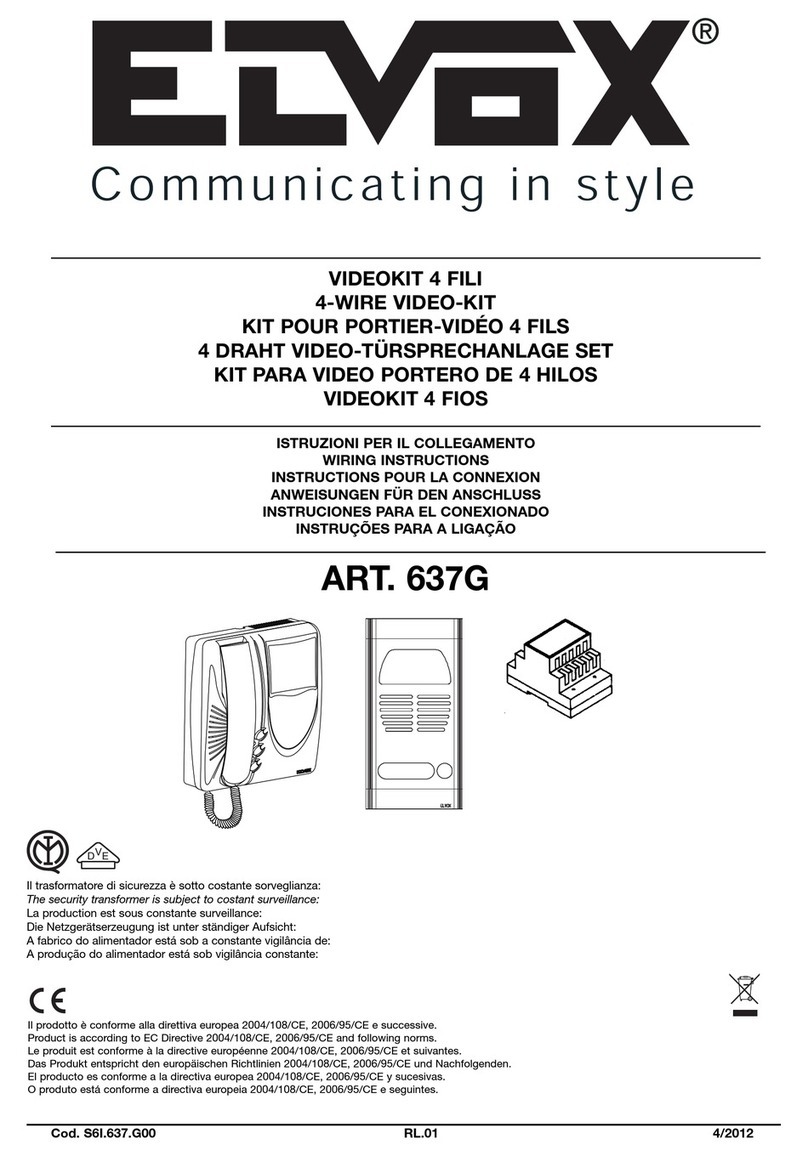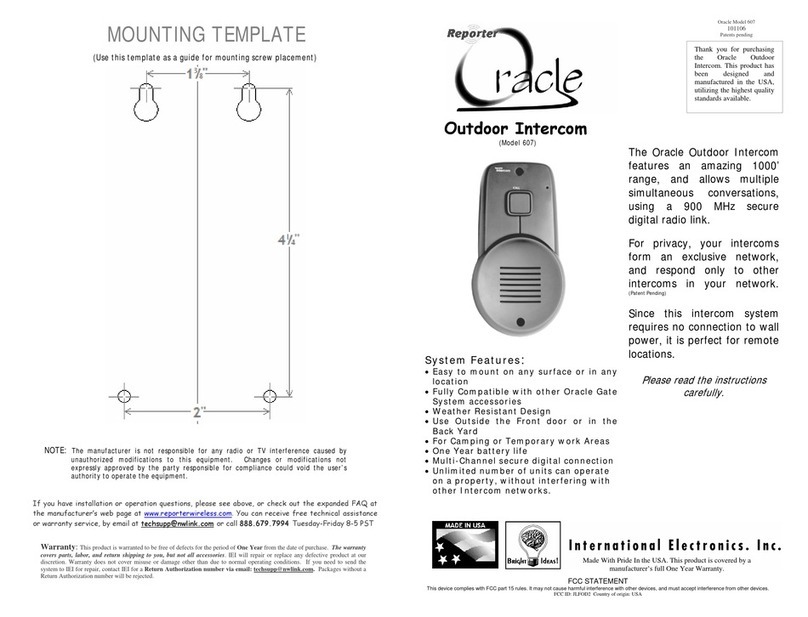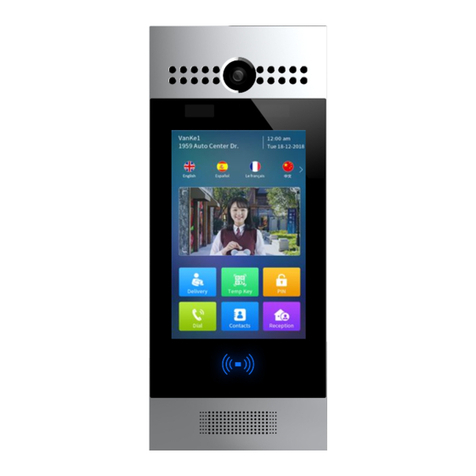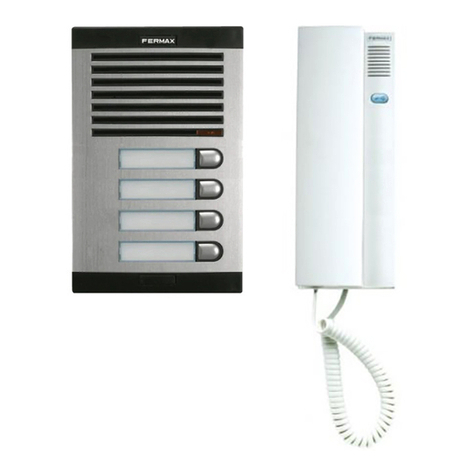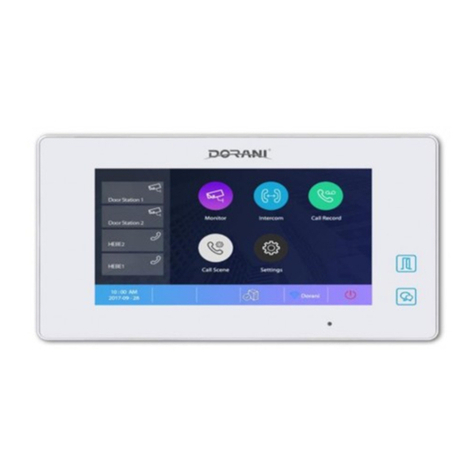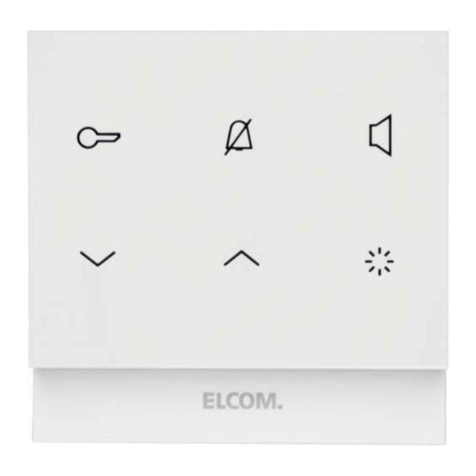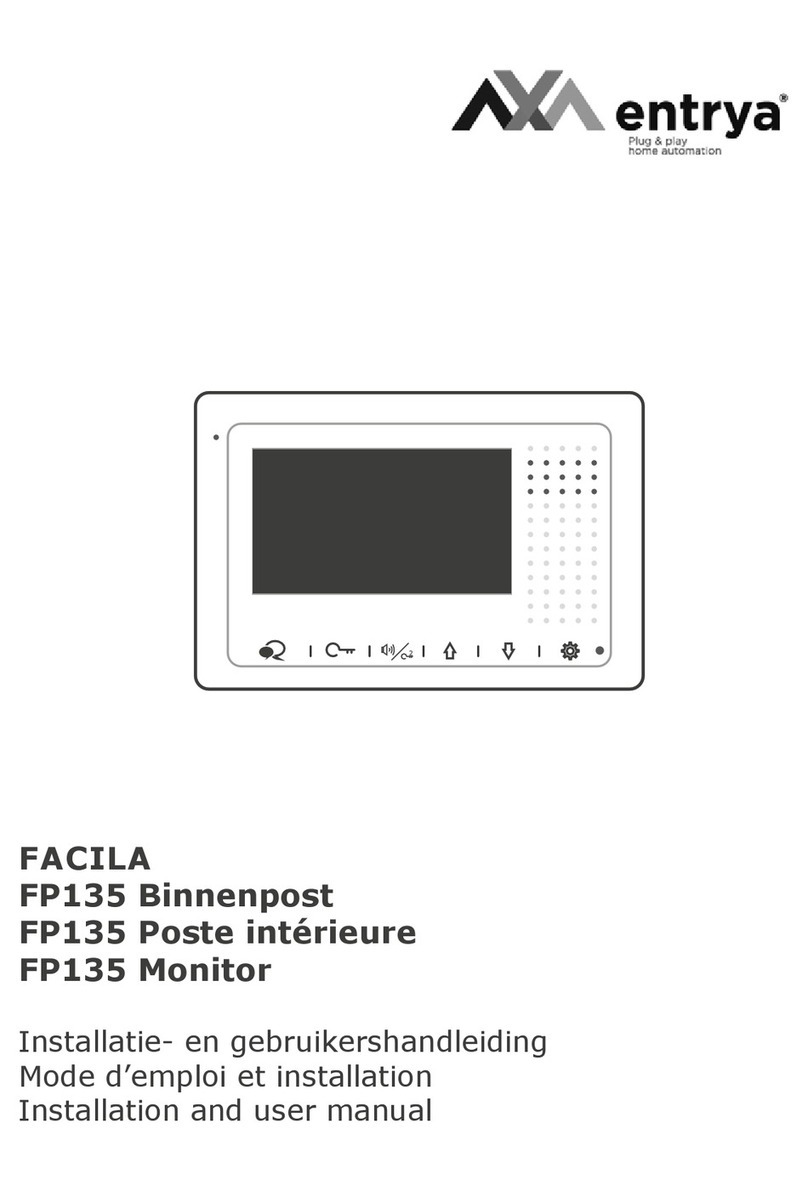Linear M&S VMC1 User manual

USA & Canada (800) 421-1587 & (800) 392-0123
(760) 438-7000 - Toll Free FAX (800) 468-1340
www.linearcorp.com
Finish Out Instructions
VMC1
Video Security Intercom System for the Home

Read Instructions: All safety and
operating instructions should be read
before installing or operating the VMC1
Video Intercom system.
Retain Instructions: The safety and
operating instructions should be retained
for future reference.
Heed Warnings: All warnings on the
appliance and in the operating instructions
should be adhered to.
Follow Instructions - All operating and use
instructions should be followed.
Water and Moisture - The appliance
should not be used near water - for
example: near bathtub, washbowl, kitchen
sink, laundry tub, in a wet basement, or
near a swimming pool, and the like. Doing
so can create a fire or shock hazards and
impair the warranty.
Attachments - Do not use attachments not
recommended by the product manufacturer
as they may cause hazards.
Ventilation - The appliance should be
situated so that its location or position does
not interfere with its proper ventilation. For
example, the appliance should not be
situated on a bed, sofa, rug, or similar
surface that may block the ventilation
openings: or, placed in a built in installation,
such as a bookcase or cabinet that may
impede the flow of air to the ventilation
openings
Heat -The appliance should be situated
away from heat sources such as radiators,
heat registers, stoves, or other appliances
(including amplifiers) that produce heat.
Power Sources - The appliance should be
connected to a power supply only of the
type described in the operating instructions
or as marked on the appliance.
Grounding or Polarization - Precautions
should be taken so that the grounding or
polarization means of an appliance is not
defeated.
Power Lines - Locate outdoor antennas
away from power lines.
Outdoor Antenna Grounding - If an
outside antenna is connected to the
receiver, be sure the antenna system is
grounded so as to provide some protection
against voltage surges and built up static
charges. Section 810 of the National
Electrical Code, ANSI/NFPA No. 70 1984,
provides information with respect to proper
grounding of the mast and supporting
structure, grounding of the lead in wire
to an antenna discharge unit, size of
grounding conductors, location of antenna
discharge unit, connection to grounding
electrodes, and requirements for the
grounding electrode (see figure).
Object and Liquid Entry - Never push
objects of any kind into this product through
openings as they may touch dangerous
voltage points or short out parts that could
result in a fire or electric shock. Never spill
liquid of any kind on the product.
Servicing - The user should not attempt
to service the appliance beyond that
described in the operating instructions.
All other servicing should be referred
to qualified service personnel.
Damage Requiring Service - The
appliance should be serviced by qualified
service personnel when:
• The power supply cord or the plug
has been damaged; or Objects have
fallen, or liquid has been spilled into
the appliance; or
• The appliance has been exposed to
rain; or
• The appliance does not appear to
operate normally or exhibits a marked
change in performance; or
• The appliance has been dropped, or
the enclosure damaged.
When the product exhibits a distinct
change in performance - this indicates a
need for service.
Replacement Parts: When replacement
parts are required, be sure the service
technician has used replacement parts
specified by the manufacturer or have the
same characteristics as the original part.
Unauthorized substitutions may result in
fire, electric shock, or other hazards.
Safety Check - Upon completion of any
service or repairs to this product, ask
the service technician to perform safety
checks to determine that the product is in
proper operating condition.
Wall or Ceiling Mounting - The product
should be mounted to a wall only as
recommended by the manufacturer.
IMPORTANT SAFETY INSTRUCTIONS
SHOCK HAZARD
This sign alerts user about un-insulated
“dangerous voltage” that poses risk of electric shock.
CAUTION!
This sign warns user about important
operating, maintenance, and servicing instructions for
this product.
Keep this manual in a safe place for future reference. To replace this manual, download available from
Linear Web site: www.linearcorp.com
2

✔DO ensure that all instructions have been followed before
power is applied to system. The installation shall be carried
out in accordance with all applicable installation rules.
✔DO use only Cat-5 & RG-6 and specified wires called out in
these instructions. The cable is designed and constructed
with electrical specifications necessary for proper audio
performance.
✔DO use only a damp cloth to clean the exterior plastics on
the VMC1 Master Station and Room Stations.
✔DO NOT use liquid or aerosols.
✔DO make gradual bends of the cable where necessary -- no
sharper than 1” radius.
✔DO dress the cables neatly with cable ties or Velcro™
wraps. Use loose or moderate pressure.
✔DO use cable-pulling lubricant only for cable runs that may
otherwise require great force to install. When cable lubricant
is used, read the instructions to be sure it is compatible with
the cable jacket material (PVC or FEP).
✔DO avoid stressing cable conductors, limit pulling tension to
25 pounds or less as specified by EIA/TIA-568A standard.
Pull cables gradually and with constant tension, taking care
not to crush or pinch bundles.
✔DO use grommets to protect the cable where passing
through metal studs or anything that can possibly damage
them.
✔DO test every installed cable run with a cable tester. “Toning”
alone is not acceptable.
✔DO label every termination point. Use a unique identifier
for each cable run. It will make moves, adds, changes, and
troubleshooting easier.
✔DO support horizontal cable bundles using board supports,
J-hooks, or cable trays.
✔DO have signal cables cross at right angles to power cables
to minimize induced interference.
✔DO always obey all local and national fire and building
codes. Be sure to “firestop” all cables that penetrate a
firewall. Use plenum-rated cable where mandated.
✔DO have a licensed electrician to run a 120 VAC line from
A DEDICATED 15-AMP BREAKER to the VMC1 power
supply.
✔DO Use Cat-5 wire for all VMC1 wire runs.
✔DO label all wire runs. Connecting the wires to the VMC1
master, room station, or door station incorrectly may result
in system damage.
✔DO NOT STAPLE CABLES. Staples cause shorts.
✔DO NOT SPLICE CABLES. Splices are unreliable and
defeat the signal isolation properties of the cable.
✔DO keep cables at least 18 inches from flourescent light
fixtures, Dimmer controls, and all other wiring. This includes
AC wiring, security cable, and other control wires. These can
cause a “hum” or “buzzing” sound.
✔DO keep cables away from objects such as heating and air
conditioning ducts, metal construction plates, and anything
else with sharp edges that can damage the cables.
✔DO follow the grounding and bonding requirements
established by Electrical Code TIA standard 607, and
equipment manufacturer’s specifications.
✔DO NOT locate the VMC1 Master Station or Room Stations
on an exterior wall.
✔DO NOT locate the VMC1 Master Station or Room Stations
in any wall cavity with any other electrical wiring in the cavity.
✔DO NOT attach non line-level audio devices or non M&S
authorized equipment to the system.
✔DO NOT power up Master Station until all stations are
connected.
✔DO NOT splice or repair cables damaged during wire
pulling, install a new cable.
✔DO NOT coil or bundle the cables. This can cause electronic
feedback.
✔DO NOT over-tighten the screws for the intercom Master
Station to prevent cracking.
✔DO NOT install any station inside the 120 VAC transformer
enclosure.
✔DO NOT tie cables to electrical conduits or lay cables
on electrical fixtures. Keep cables at least 16” away from
fluorescent lights, HID light fixtures, or dimmers.
✔DO NOT allow the cable to be sharply bent or kinked at any
time.
✔DO NOT install cables “taut” anywhere. Good installation
should have cables loose, but never sagging.
✔DO NOT run signal and power cables parallel without
adequate separation to minimize interference.
✔DO NOT exert more than 25 pounds of tension on 4-pair
cables.
✔DO NOT step on Cat-5 cable during installation.
✔DO NOT overtighten the cable ties, apply cable ties loosely,
with random spacing.
✔DO NOT untwist the wire pairs in Cat-5 cable more than
necessary to avoid crosstalk.
IMPORTANT DO’S & DON’TS
IMPORTANT SAFETY INSTRUCTIONS
CAUTION!
This sign warns user about important
operating, maintenance, and servicing instructions for
this product.
Keep this manual in a safe place for future reference. To replace this manual, download available from
Linear Web site: www.linearcorp.com
3

Introduction
Designed for installation in new home, the VMC1 is a whole-house music and video intercom
communications system. It is designed to provide years of enjoyment and service to the homeowner.
Linear audio products are backed with more than 50 years of experience in the design and manufacture
of precision acoustical equipment for the home. To ensure that the homeowners receives the high-
quality music and voice reproduction that the system is designed to deliver, it is important that each step
of the installation be done carefully. In the event you need troubleshooting assistance, please call our
technical staff at 1-800-421-1587. Prior to installing the VMC1 system, read and observe the Important
Safety Instructions. Our web address is www.linearcorp.com.
Contents
Introduction ....................................................................4
Table of Contents. . . . . . . . . . . . . . . . . . . . . . . . . . . . . . . . . . . . . . . . . . . . . . . . . . . . . . . . . . . . . . . . 4
Materials Required . . . . . . . . . . . . . . . . . . . . . . . . . . . . . . . . . . . . . . . . . . . . . . . . . . . . . . . . . . . . . . 5
Tools required:..................................................................5
Master Station Installation. . . . . . . . . . . . . . . . . . . . . . . . . . . . . . . . . . . . . . . . . . . . . . . . . . . . . . . . . 6
Master Unit ....................................................................6
VMC1RS Room Station. . . . . . . . . . . . . . . . . . . . . . . . . . . . . . . . . . . . . . . . . . . . . . . . . . . . . . . . . . 10
Installation of VMC1RS Room Station. . . . . . . . . . . . . . . . . . . . . . . . . . . . . . . . . . . . . . . . . . . . . . . 11
Door Stations..................................................................12
Installation of Door Station . . . . . . . . . . . . . . . . . . . . . . . . . . . . . . . . . . . . . . . . . . . . . . . . . . . . . . . 12
VMC1 Night Stand Station. . . . . . . . . . . . . . . . . . . . . . . . . . . . . . . . . . . . . . . . . . . . . . . . . . . . . . . . 16
Master Station Setup / Programming . . . . . . . . . . . . . . . . . . . . . . . . . . . . . . . . . . . . . . . . . . . . . . . 17
Master Station Programming. . . . . . . . . . . . . . . . . . . . . . . . . . . . . . . . . . . . . . . . . . . . . . . . . . . . . . 18
Other Options Notes . . . . . . . . . . . . . . . . . . . . . . . . . . . . . . . . . . . . . . . . . . . . . . . . . . . . . . . . . . . . 23
System Test Notes. . . . . . . . . . . . . . . . . . . . . . . . . . . . . . . . . . . . . . . . . . . . . . . . . . . . . . . . . . . . . . 24
Setting the Radio . . . . . . . . . . . . . . . . . . . . . . . . . . . . . . . . . . . . . . . . . . . . . . . . . . . . . . . . . . . . . . 25
Room Station Setup / Programming . . . . . . . . . . . . . . . . . . . . . . . . . . . . . . . . . . . . . . . . . . . . . . . . 26
Single Digit Versus Double Digit . . . . . . . . . . . . . . . . . . . . . . . . . . . . . . . . . . . . . . . . . . . . . . . . . . . 26
Single Digit & Double Digit Programming . . . . . . . . . . . . . . . . . . . . . . . . . . . . . . . . . . . . . . . . . . . . 26
Door Station Setup . . . . . . . . . . . . . . . . . . . . . . . . . . . . . . . . . . . . . . . . . . . . . . . . . . . . . . . . . . . . . 27
Changing the Chime . . . . . . . . . . . . . . . . . . . . . . . . . . . . . . . . . . . . . . . . . . . . . . . . . . . . . . . . . . . . 28
Chime Voltage Output Options . . . . . . . . . . . . . . . . . . . . . . . . . . . . . . . . . . . . . . . . . . . . . . . . . . . . 29
Advanced Installation Options. . . . . . . . . . . . . . . . . . . . . . . . . . . . . . . . . . . . . . . . . . . . . . . . . . . . . 29
Limited Warranty ...............................................................32
Table of Contents
4

Tools required:
Required Recommended
Phillips screwdriver (#2) Voltmeter
Standard flathead screwdriver Punchdown tool
Hammer Mounting screws, various sizes
Wire stripper/cutter COAX cable
Level CAT5 cable
14/18 Gauge Wire H628/H629 (two) Data Hubs
H629 features 8 individual CAT-5
circuits, 110 punchdown connectors
Materials Required
WARNING
ALL AC ELECTRICAL CONNECTIONS TO THE POWER SOURCE TE6D POWER SUPPLY MUST BE MADE BY A LICENSED ELECTRICIAN AND
MUST OBSERVE ALL NATIONAL AND LOCAL ELECTRICAL CODES
5

Master Unit
Prepare area and follow these instructions for installation of the Master Unit:
1. Pull the CAT5 and all other cables through the wall mount.
2. Lay the master face down on the bubble wrap provided in the packaging.
3. Fit all the Blue Block connectors to the terminal headers on the rear of the master, grove side down.
4. Terminate all the remaining wiring as directed in the Master Terminations section.
5. If accessible, remove the screw that is temporarily holding the TE6D power supply in place. If this screw
is left in place, do not use this location to attach the Master Unit to the Mounting Bracket.
6. Fit the back housing into the wall and secure using the 6G x 1½” screws provided.
7. Hang the master front from the top of the back housing.
8. Push the bottom of the plastic front clipping it into the plastic back
CONNECTING POWER TOTHE MASTER UNIT
The Master Station has a dedicated pair of terminals labelled “VDC IN” on the termination PCB for the
connection of the power supply.When using DC power supply, be sure the Positive lead of the power supply
connects to the 13.8V terminal and the Negative lead of the power supply connects to the 0V terminal.
Master Station Installation
CAT-5 Cable
Strip cable jacket
back 2 inches
Before connecting,
Strip each wire back
1/4 Inch Maximum
Keep cable
pairs twisted
to reduce hum
Figure 1 Figure 2
6

VMC1 Master Terminations
VDC IN 13.8V Connect red wire from TE6D Power Supply (See Figure 4)
0V - Input fromTE6D
power unit Connect black wire from TE6D Power Supply
INTERCOM (Figure 4)
POS Connects to Corresponding terminal at Room and Door stations
(Green White from terminal block)
NEG Connects to Corresponding terminal at Room and Door stations
(Green from terminal block)
TC Connects to Corresponding terminal at Room and Door stations
(Orange White from terminal block)
VLC Connects to Corresponding terminal at Room stations only
(Orange from terminal block)
VLC1 Connects to VLC terminal at Door station 1
(Orange from Video Door Station)
VLC2 Connects to VLC terminal at Door station 2
(Orange from Video Door Station)
VLC3 Connects to VLC terminal at Door station 3
(Orange from Video Door Station)
SHLD Not Connected (except where shielded cable used)
COM1 Connects to Corresponding terminal at Room and Door stations
(Blue White from terminal block)
Master Station
FROM
DOOR
STATION
FROM
ROOM
STATION
FROM
NIGHTSTAND
STATION
FROM
ROOM
STATION
FROM
ROOM
STATION
CAT5 to Master Station
MATCH
WIRE COLORS
ON EACH TERMINAL
USE TERMINAL BLOCK TO COMBINE CAT-5 CABLES FROM STATIONS
8-POSITION
TERMINAL
BLOCK
GRN/WHTGRN ORG/WHTORG BLU/WHTBLU BRN/WHTBRN
USE WOOD SCREWS
TO SECURE TERMINAL
BLOCK TO STRUCTURE
Figure 3
7

Master Station
VMC1 Master Terminations
COM2 Connects to Corresponding terminal at Room and Door stations
(Blue from terminal block)
MUS1 Connects to Corresponding terminal at Room stations only
(Brown White from terminal block)
MUS2 Connects to Corresponding terminal at Room Stations only
(Brown from terminal block)
AUX Connects toYellow AUX Activation Wires from Room stations
MUSIC INPUT (See Figure 4)
The VMC1 Master is outfitted with a 3.5mm music input jack on the front that is pre-wired to the music input
connector.
LCH Left channel audio (White Wire)
GND Audio output GND (Blue Wire)
RCH Right channel audio (Red Wire)
LOCK OUTPUT (See Figure 5)
LK1 Switched negative for door lock 1 relay
LK2 Switched negative for door lock 2 relay
LK3 Switched negative for door lock 3 relay
COM + Positive 12V for all three lock relays
(Relay coil resistance should be 240 ohm or greater)
INPUTS / OUTPUTS (See Figure 5)
G/STAT Connects to optional reed switch for Door Open Status Ground
COM + Connects to optional reed switch or AUX 1, AUX 2 (12V)
AUXILLIARY SWITCHES (See Figure 5)
AUX1 Connects to optional activation Device #1 Ground
AUX2 Connects to optional activation Device # 2 Ground
Figure 4
8

Master Station
CAM PWR (See Figure 5)
12V & 0V Regulated 12V output for powering stand-alone cameras (See Figure 5)
CAM 1
VID1 Video Signal from door station 1 camera (coax center or Brown White on CAT5) or other
analog NTSC video device
GND Video GND from camera on Door Station 1 (Coax Ground or Brown on CAT5) or other
analog NTSC video device
CAM 2
VID2 Video Signal from door station 2 camera (Coax Center or Brown White on CAT5) or other
analog NTSC video device
GND Video GND from camera on door station 2 (Coax Ground or Brown on CAT5) or analog
NTSC device
CAM 3
VID3 VID3 - Video Signal from door station 3 camera (Coax Center or Brown White on CAT5)
or other analog NTSC video device
GND Video GND from camera on door station 3 (Coax Ground or Brown on CAT5 Brown) or
other analog NTSC video device
Figure 5
WARNING
ALL AC ELECTRICAL CONNECTIONS TO THE POWER SOURCE TE6D POWER SUPPLY MUST BE MADE BY A LICENSED ELECTRICIAN AND
MUST OBSERVE ALL NATIONAL AND LOCAL ELECTRICAL CODES
VMC1 Master Terminations
9

VIDEO OUT (See Figure 6)
SIG Video signal for external video displays
GND Video GND for external video displays
12V This output can be used to activate a 12V relay(s) which switches 12V DC to external NTSC video
display(s)
0V Provides 0V for the external video display control relay
FM
300Ω
FM1 & FM2 - FM antenna using 75Ωcoaxial cable and connected to master using 75Ωto 300Ω
balun)
AM 75ΩSIG & GND - AM Loop antenna wired back to master using provided antenna cable
Figure 6
VMC1RS Room Station
VMC1 Master Terminations
10

Installation ofVMC1RS Room Station
1. Assemble the PCB, keymat, and plastic insert to the metal plate as shown in Figure 7
2. Pull the CAT5 cable through the hole in the back of the Room Station back box.
3. Secure the Room Station back box in the pre-cut cavity in the wall. Be sure the access hole is off-center
to the right.
4. Fit the Blue Block connectors to the PCB and terminate wires from the cable per the Room Station
Terminations chart
5. Secure the metal plate to the back box using the screws provided
6. Fit the trim ring in position if required
7. Clip the plastic front onto the back box
VMC1RS Room Station Terminations
POS Green White
NEG Green
TC Orange White
VLC Orange
SHLD Not Connected (except where shielded cable used)
COM1 Blue White
COM2 Blue
MUS1 Brown White
MUS2 Brown
AUX Connects toYELLOW wire for AUX activation
VMC1RS Room Station
Figure 7
11

Door Stations
INSTALLATION OF VMC1DS VIDEO DOOR STATION
1. If using the Door Release or Chime Activated CO use a Phillips head screw driver, remove the back plate
retaining screw at the top of the back plate. If not skip to step 5.
2. Attach the included three wire (Black, Blue & White) wire harness to the connector in the middle of the
unit (See Figure 8 & 8A).
3. Carefully drill a 3.5mm hole in the back plate and pull the three wires through from the inside.
4. Re-attach the back plate to theVMC1VDS.
5. Connect the CAT5 wiring to the screw down terminals as shown on the VMC1VDS Door Station
Terminations chart. If unit is to be directly exposed to inclement weather conditions, the installation of the
VDSWS-T Weather Shield is strongly recommended. Be sure to feed the CAT5 wires through the back of
the VDSWS-T prior to connecting to the VMC1VDS screw down terminals.
6. Remove the metal front cover of the VMC1VS, using the included tool, by removing the hex screw at the
bottom of the unit.
7. Mount the VMC1DS (and DVSWS-T if appropriate) onto the wall in the selected location. Do not securely
attach the unit as it may be necessary to remove the back plate to adjust volume, ring tone and CO
operation when the entire VMC1 Security Video Intercom system is configured and tested.
VMC1 input.ai
VMC1 input.ai
POS NEG TC VLC Com1 Com2
Front View
VMC1VDS Door Station
Camera
Interior Back Cover VMC1VDS
Door Station Camera
Drill 3.5mm hole here
Figure 8
12

VMC1VDS Door Station Terminations
6-WAY Screw DownTerminal
POS Green White
NEG Green
TC Orange White
VLC Orange
COM1 Blue White
COM2 Blue
BNC Connector
Center Positive (Coax Cable) or Brown White (Cat5)
Ground Shield (Coax Cable) or Brown (CAT5)
Optional Control OutputWire Harness (See Figure 8 & 8A)
BlackWire Switched Negative for Chime Relay
BlueWire Switched 12V Positive for Chime or Door Strike
WhiteWire Switched Negative for Door Strike relay
Door Stations
Black Wire
Blue Wire White Wire
Wire Harness
PCB VMC1VDS Interior
Wire harness clips in here
Figure 8A
13

Door Stations
INSTALLATION OF VMC1DS-S/BZ & VMC1VDS-S/BZ DOOR STATIONS
1. Assemble the PCB and plastic insert and fit into the metal plate.
2. Pull the CAT5 cable through the hole in the back of the door station back box.
3. Secure the door station back box into the pre-cut cavity in the wall.Be sure the access hole is off center
and to the right. Incorrect installation of this box precludes secure attachment in Step 7. Also, should unit
be exposed to harsh weather, install the DSWS Weather Shield for protection.
4. Fit the two (2) position blue connector block onto the PCB at locationTB3, grove side down.(VMC1VDS-S
and VMC1VDS-BZ Video Door Stations only)
5. Fit the ten (10) position blue connector block onto the PCB at location TB1, grove side down.
6. Terminate the wires from the cable per the Door Station Terminations Chart.
7. Secure the metal plate to the back box using the screws provided.
8. Fit the trim ring in position if required. This is not required if the weather shield (DSWS) is used.
9. Clip plastic front onto back box.
NOTE: Use of the weather shield (DSWS) is recommended where the station may be exposed to weather.When fitted
with the weather shield, the unit has been designed to meet the ANSI/IEC 60529 IP31 Ingress Protection Rating.
VMC1DS-S/BZ Door Station Terminations (See Figure 9)
10-WAY Blue Connector Block
POS Green White
NEG Green
TC Orange White
VLC Orange
SHLD Not Used
COM1 Blue White
COM2 Blue
CH -Switched Negative for Chime Relay
+Switched 12V Positive for Chime or Door Strike
LK Switched Negative for Door Strike Relay
VMC1DS-S/BZ Door Station Terminations
2-WAY Blue Connector Block
V-SIG Positive (Coax Cable) or Brown White (From Cat-5)
SHLD Shield (Coax Cable) or Brown (From CAT-5)
NOTE: Shielded COAX cable is recommended over twisted pair CAT5 cable for the video signal. Using the Brown /Brown
White twisted pair from the CAT-5 cable may generate video artifacts from external interferences.
Figure 9
14

Door Stations
Video Door Station (VMC1VDS-BZ)
1. Camera
2. Speaker
3. Camera Light
4. Doorbell
15

VMC1 Night Stand Station
12345678
Figure 10
VMC1TTS Night Stand Station
The Night Stand station connects to a wall plate by
means of a CAT5 Patch Lead (RJ45 to RJ45)
1. The patch lead should be “straight through”
and not “crossover” in that the wire color coding
should be the same at both ends of the lead.
2. The wall plate used is to be fitted with a CAT5
IDC Jack marked with T568A color coding.
(Many CAT5 IDC Jacks have both T568A and
T568B color coding and are marked by A or B
respectively)
3. The CAT5 cable from the master wires to the
CAT5 IDC connector according to the T568A
color coding standard.The pin numbering for the
RJ45 jack on the wall plate and on the Night Stand Station is as per Figure 10.
The following chart provides the pin/wire configuration for the Night Stand station as well as the
corresponding T568A and T568B wiring conventions:
Night Stand Station
Pin Function T568-A T568-B
1 POS GREEN/WHITE ORANGE/WHITE
2 NEG GREEN ORANGE
3 TC ORANGE/WHITE GREEN/WHITE
4 COM2 BLUE BLUE
5 COM1 BLUE/WHITE BLUE/WHITE
6 VLC ORANGE GREEN
7 MUS1 BROWN/WHITE BROWN/WHITE
8 MUS2 BROWN BROWN
16

Master Station Setup / Programming
VOLUME
+ (higher)
__ (lower)
PLUS + & MINUS -
FILTER
LOCK
CLEAR
PRIV + MON
UP/DOWN ARROW
KEYS
1
2
3
4
INITIAL POWER-UP
On power-up the master displays a blue
welcome screen showing the applicable
software version.
1. Press CLEAR to clear screen
ENTERING PROGRAM MODE
2. Press PRIV and MON buttons
simultaneously.
The GENERAL OPTIONS menu is
displayed.
NAVIGATING IN PROGRAM MODE
3. Press the UP/DOWN arrow keys to navigate
up or down.
4. Press PLUS + or MINUS - to alter value
Use PREV/NEXT MENU to navigate
between menus
17

GENERAL OPTIONS MENU
Selections Description Factory Default Installer/
Consumer
PREV/NEXT
Menu Move between Menus n/a Consumer
8WIRE / 6WIRE Programs Master Unit for an 8 or
6 Wire operation, depending on
installation
8 Wire Installer
BACKLIGHT Sets Master Unit keypad backlight
intensity ON - M (Medium) Consumer
SINGLE /
DOUBLE DIGIT Programs Master Unit for single or
double digit room station operation Single Installer
STATION
NUMBER Assigns a Room Station number to
Master Unit Number #1
General Options Menu Notes
PREV/NEXT
Menu Operates for all menus
8WIRE / 6WIRE For 6 wire operation, wire links are required between
COM1 and MUS1 and between COM2 and MUS2 at
Master only.
8 WIRE is the default setting
however 6 WIRE can be selected
to cater for existing cabling
having only 6 conductors
BACKLIGHT Options are OFF, LOW, MEDIUM (Medium is Default) HIGH
SINGLE /
DOUBLE DIGIT Master and Room stations are programmed to same setting.
Double digit setting is required for systems where MORE than 7 stations to call .
SINGLE DIGIT is the DEFAULT & Calls up to 7 individual stations (or 7 groups of
stations).
STATION
NUMBER Master can be programmed from 1 to 7 for Single Digit
Double Digit can be programmed from 11 to 17, 21 to 27, 31 to 37
Master Station Programming
18

Master Station Programming
STATION OPTIONS MENU
Selections Description Factory
Default Installer/ Consumer
PREV/NEXT N/A Consumer
ADDITIONAL
DISPLAY /
VIDEO ROOM STN
Not used at this time Installer
30 Sec
DISPT-OUT
1/5/10/20/60 Min
Duration of Video Out Feed after doorbell
rings 30 seconds Consumer
# CAM DOOR STN Shows number of door stations with
cameras 1 Installer
# NON-CAM
DOOR STN Number of NON Camera door stations in
system 0 Installer
ADDITIONAL CAM Number of NTSC non door cameras in
system 0 Installer
Station Options Notes
ADDITIONAL
DISPLAY /
VIDEO ROOM
STN
Additional Display is Default & used where extra display(s) or monitors are connected
via the VIDEO OUT terminals
30 Sec
DISPT-OUT
1/5/10/20/60 Min
Setting changes Video Out - Determines time duration for the Video Out display in
seconds when the video from the camera activated by a door chime before switching
back to default display
# CAM DOOR STN Sets the number of door stations that have an built-in external camera.
Options are 1, 2 or 3.
If “1 CAM DOOR STN” is selected, door station No.1 (wired to VLC1) is door station
with camera.
If “2 CAM DOOR STN” is selected, door stations 1 & 2 (wired toVLC1 and VLC2) are
door stations with cameras.
# NON-CAM
DOOR STN Sets number of door stations with no built-in or associated external camera. Options are
1, 2 or 3.
If “2 NON-CAM DOOR STN” is selected, door stations 2 & 3 (wired toVLC2 and VLC3)
are door stations without cameras.
If “3 NON-CAM DOOR STN” is selected, door station No. 3 (wired to VLC3) is door
station without a camera.
19

AUDIO OPTIONS MENU
Selections Description Factory
Default Installer/
Consumer
PREV/NEXT
Menu Move between menus n/a Consumer
SYSTEM RADIO
VOLUME
0 to 100
Increase or decrease radio volume
throughout system. 16 Consumer
SYSTEM AUX
VOLUME 0-100 Increase or decrease auxiliary music
volume throughout system 16 Consumer
LOCAL COMMS
VOLUME
0-100
Increase or decrease intercom volume
throughout system 10 Consumer
Audio Options Notes
SYSTEM RADIO
VOLUME Levels are best when music is heard at a desired level in room stations with volume
controls set for normal conversational levels Adjustments are used to balance the
volume levels for radio and auxiliary music so they are at same levels when switching
between them.
SYSTEM AUX
VOLUME
LOCAL COMMS
VOLUME Allows volume level for communication at Master to be pre-set to a desired level. In
normal operating mode, adjusting the volume using the volume + and – keys during
communication:
changes the programmed level
is independent of the music level
is independent of the communication level
Master Station Programming
20
Other manuals for M&S VMC1
1
Table of contents
Other Linear Intercom System manuals

Linear
Linear 2GIG-DBELL1-345 Configuration guide
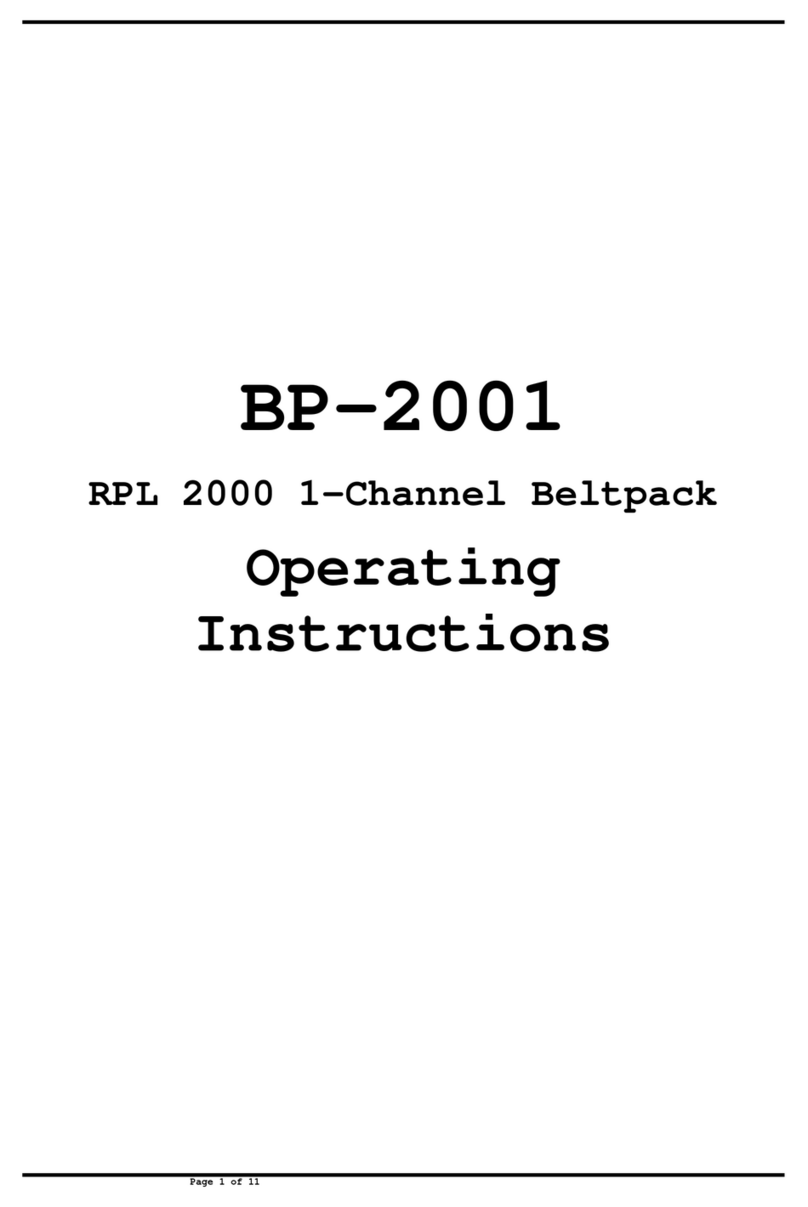
Linear
Linear BP-2001 User manual
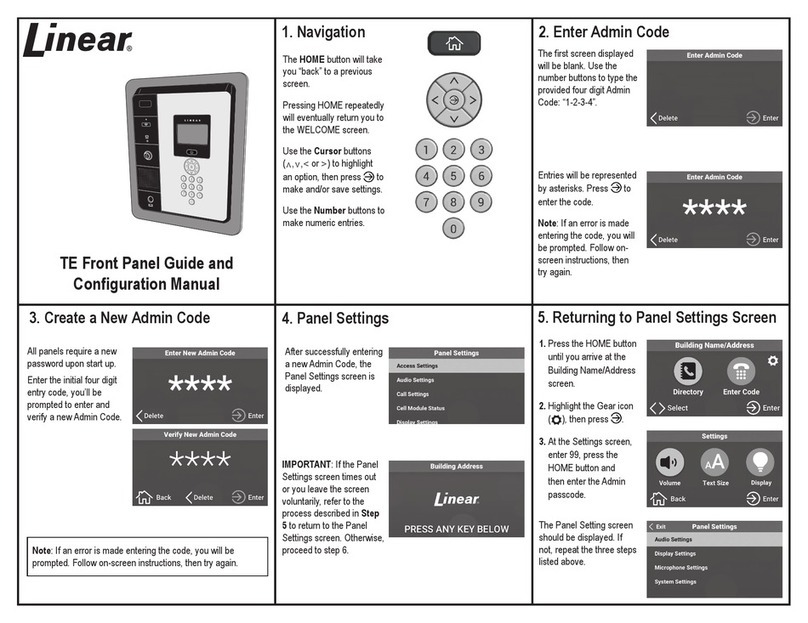
Linear
Linear TE Instruction sheet
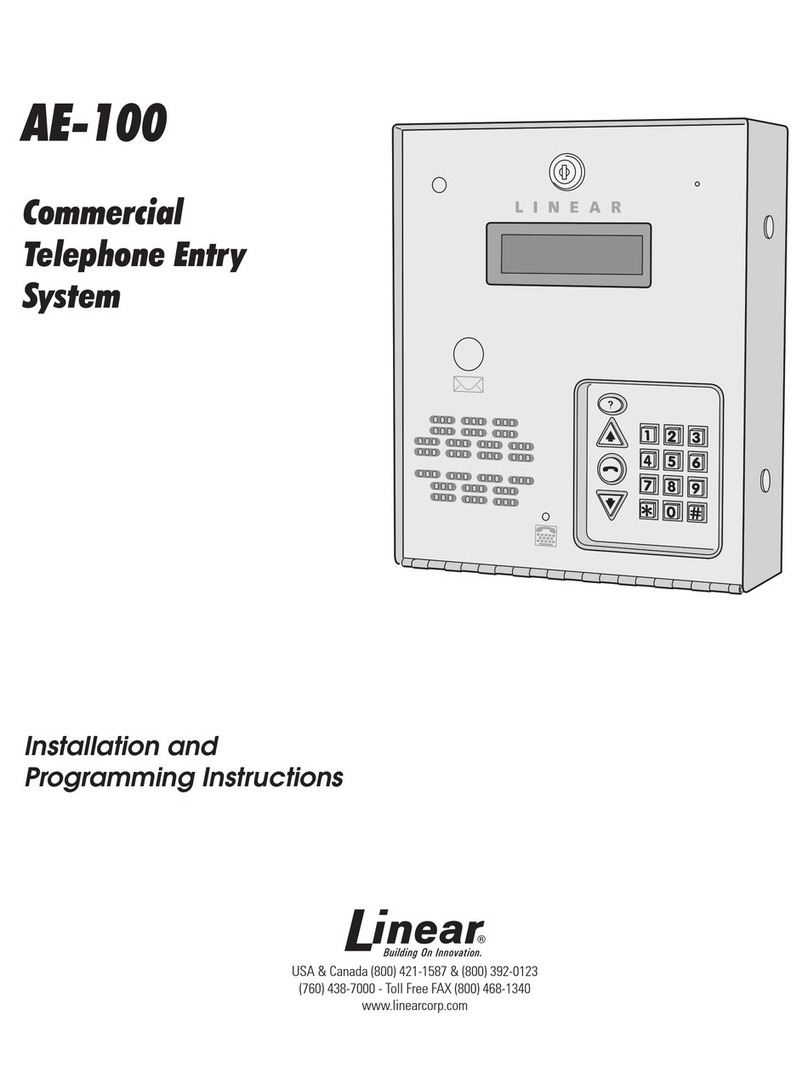
Linear
Linear ACCESS AE-100 Guide Technical specifications
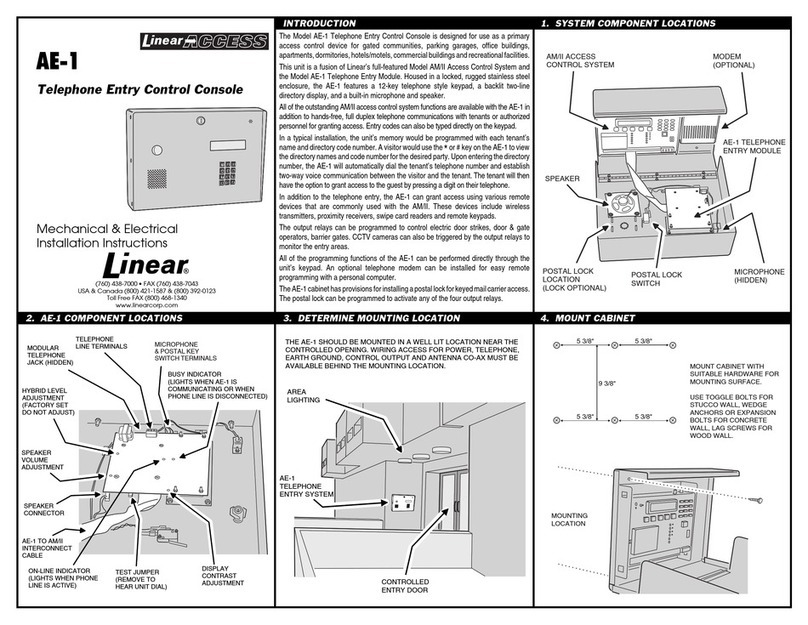
Linear
Linear AE-1 User manual
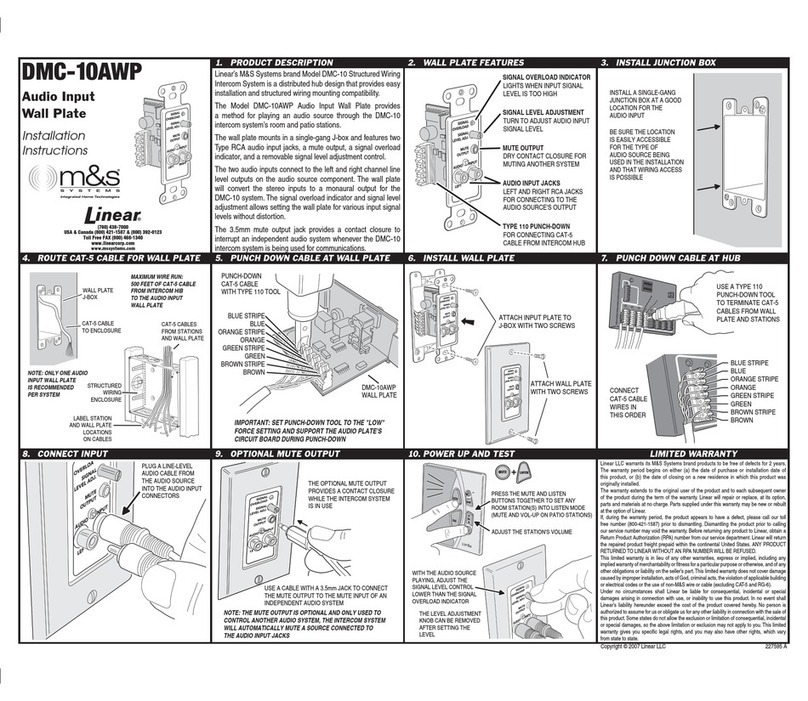
Linear
Linear DMC-10AWP User manual
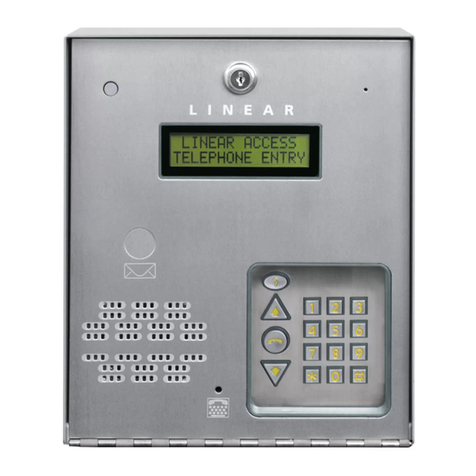
Linear
Linear ACCESS AE-100 Guide User manual
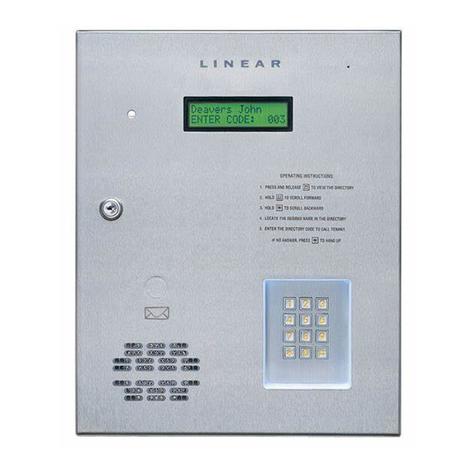
Linear
Linear AE-1000 User manual
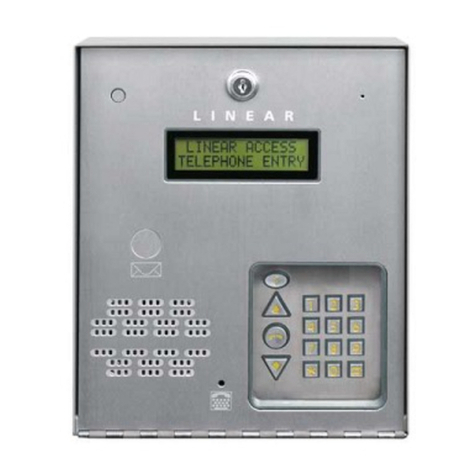
Linear
Linear ACP00937 Technical specifications
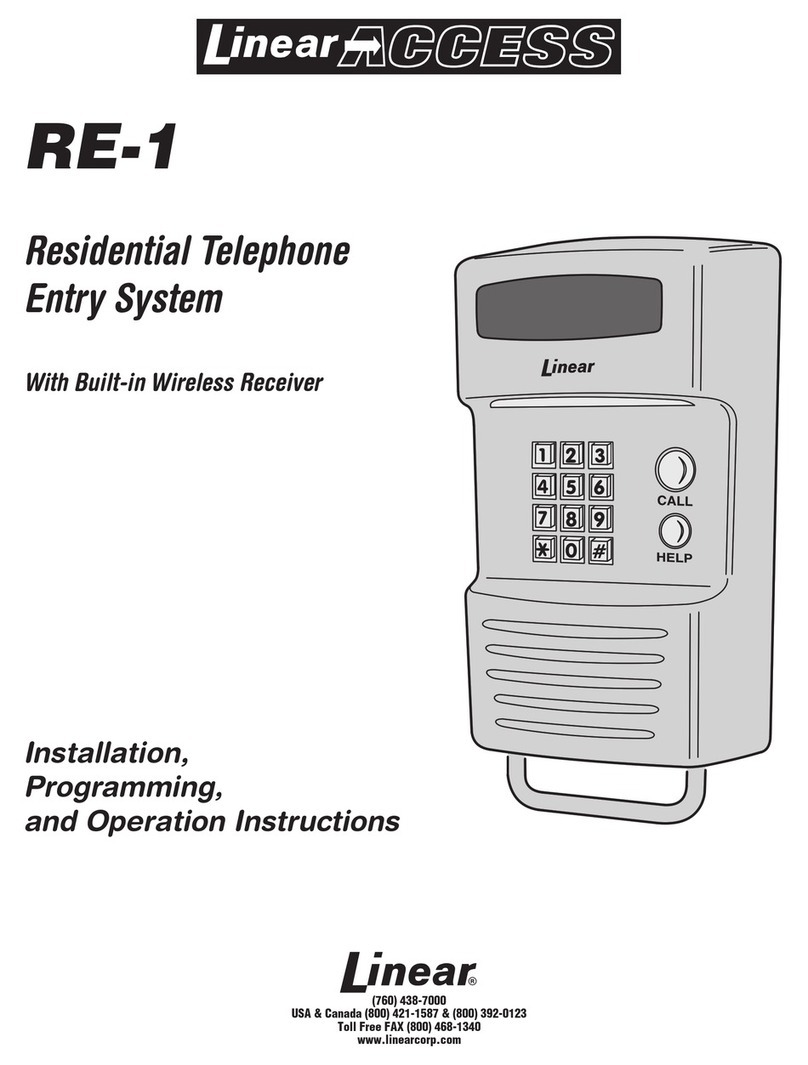
Linear
Linear RE-1 User manual
